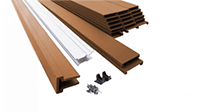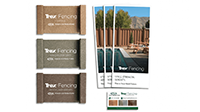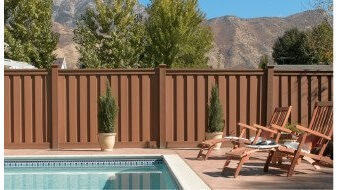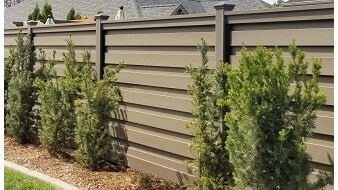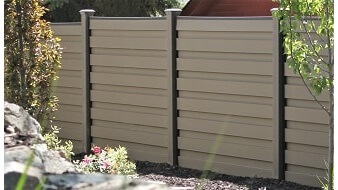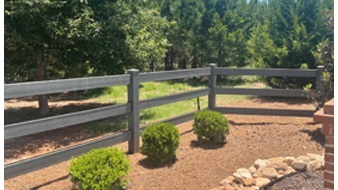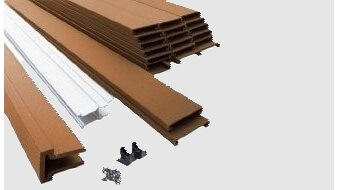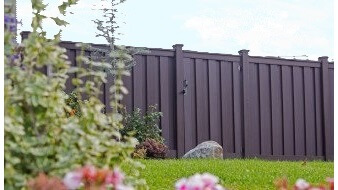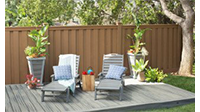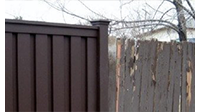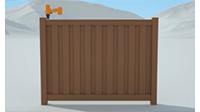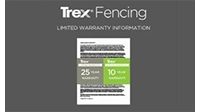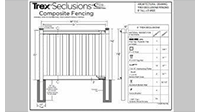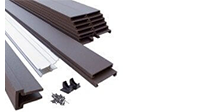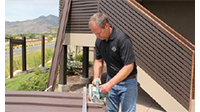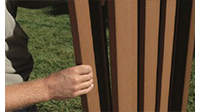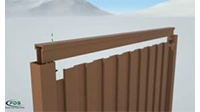Trex Fencing Care & Cleaning Guide
MAINTAIN THE BEAUTY
Any exterior building material may require periodic cleaning. If you choose to clean your fence, we recommend a composite deck cleaner or a combination of soap, hot water, and a soft bristle brush. Ideal times to clean are just after installation and then as needed. This will help to maintain the beauty of your Trex® composite fence.
TREX® PRODUCT CLEANING GUIDE
| PROBLEM | SOLUTION |
|---|---|
| Dirt and Debris | Clean the fence to remove dirt and debris. Soap, hot water and a soft brush are all that is needed. |
| Chalk Markings | Most colored chalk lines are permanent. As an alternative to regular chalk, use either baby powder or a product such as Irwin Strait-Line dust-off marking chalk, available at www.irwin.com. (Strait-Line is a registered trademark of Irwin Industrial Tool Company.) |
| Water Spots, Leaf Staining and Wood Tannins | Tannin leaching occurs naturally in Trex® and all wood-based products. Allow at least 12 weeks of normal weathering for the staining to become less visible. This process may be hastened through the use of a product containing oxalic or phosphoric acid, commonly known as a deck brightener*. |
| Scuffs & Abrasions | Scuffs and abrasions can fade or disappear naturally after 12-16 weeks of weathering. Weathering can be accelerated with a product containing oxalic or phosphoric acid, commonly known as a deck brightener.* If a reduction in the visibility of a scuff or abrasion is desired before the fence weathers, WD-40 can be applied as a temporary solution. Apply a small amount of WD-40 to a rag and lightly rub it into the affected area to darken the marred area. |
| Rust Stains, Ground-In Dirt and Grime and Pigment Staining | Use a cleaning product containing oxalic or phosphoric acid base, also known as a deck brightener, to lighten or remove the rust or dirt. The product may need to sit on a stain 10-15 minutes before rinsing*. |
| Oil and Grease Stains | Rinse the stain with hot water as soon as possible. Use a product such as Pour-N-Restore (www.pour-n-restore.com) as directed for any remaining staining. Test in a small area first as this may remove some of the colorant from the fencing surface. (Pour-N-Restore is a registered trademark of Edgewater Industries.) |
| Mold & Mildew | If your area is prone to mold and mildew growth, semi-annual cleaning (typically Spring and Fall) of your fence is important to prevent the build-up of pollen and other debris that can support the growth. Use conventional fence washes or cleaners that contain sodium hypochlorite (bleach) and detergent (refer to the Trex Mold Technical Bulletin for specific recommendations)*. |
| Pressure Washer | Trex does not recommend the use of a pressure washer. The use of a pressure washer on fence surface could damage the fencing and will void the warranty with respect to any condition caused by the pressure washing. |
| Sanding | Trex Company does not recommend sanding. Sanding will change the appearance of the surface of Trex® material and will void the warranty with respect to any condition caused by such sanding. |
| Disposal | Trex® products should be disposed with normal construction debris or household waste. Do not burn Trex® products. |
* Use of products containing bleach or oxalic/phosphoric acid will lighten the surface of Trex®. Use in an inconspicuous area to determine if the effect achieves the results you want. Neither product will affect the structural integrity of Trex® composite fencing.
Mold and mildew
To get mold or mildew off your fence, you can employ a variety of methods. Mold and mildew can grow on any surface that provides a food source (usually microscopic organic particles that contain cellulose) and it requires a warmer, humid climate to thrive. These organisms do not feed on Trex itself, but a build up of microscopic organic materials such as grass clippings or pollen can settle on the fence and this can attract mold or mildew which in turn attaches itself to the fence. The first thing to evaluate is what you can do to change the environment where the mold and mildew is growing to reduce or eliminate regrowth. That may mean trimming back bushes or cleaning up organic debris that has built up around the fence. Once you’ve figured that out, to get mold or mildew off your fence try white vinegar. Fill a spray bottle with vinegar and apply it to the affected area. Use a soft bristle brush to scrub in the vinegar and lift the mildew off the surface. Hose off once you are done scrubbing. If this doesn’t produce the results you need, contact your local garden supply store and ask for help recommending a mildewcide. Follow the directions for application and safety. Before applying any potential solution, test a small area of your fence to see if it gets the mildew off with acceptable results.



